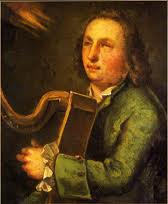Annotation:Lady Blayney: Difference between revisions
No edit summary |
No edit summary |
||
| Line 16: | Line 16: | ||
</font></p> | </font></p> | ||
<p><font face="garamond, serif" size="4"> | <p><font face="garamond, serif" size="4"> | ||
''Printed sources'': '''Complete Collection of Carolan's Irish Tunes''', 1984; No. 5, p. 28. Mulholland ('''Ancient Irish Airs'''), 1810; p. 54. O'Neill (Krassen), 1976; p. 243. O'Neill ('''Music of Ireland: 1850 Melodies'''), 1903; No. 693, p. 127. O'Sullivan ('''Carolan: The Life, Times and Music of an Irish Harper'''), 1958; No. 5, p. 106. O'Sullivan/Bunting, 1983; No. 61, pp. 94-95. | ''Printed sources'': Bunting ('''Ancient Music of Ireland'''), 1840; No. 61, p. 45. '''Complete Collection of Carolan's Irish Tunes''', 1984; No. 5, p. 28. Mulholland ('''Ancient Irish Airs'''), 1810; p. 54. O'Neill (Krassen), 1976; p. 243. O'Neill ('''Music of Ireland: 1850 Melodies'''), 1903; No. 693, p. 127. O'Sullivan ('''Carolan: The Life, Times and Music of an Irish Harper'''), 1958; No. 5, p. 106. O'Sullivan/Bunting, 1983; No. 61, pp. 94-95. | ||
<br> | <br> | ||
<br> | <br> | ||
Revision as of 01:03, 5 May 2015
Back to Lady Blayney
LADY BLAYNEY (Bantiaghearna Blanadh). AKA - "Planxty Lady Blayney." Irish, Air (2/4 or cut time, "spirited"). C Major. Standard tuning (fiddle). AB. Turlough O'Caroland composed this air, recorded by the Belfast Northern Star of July 15th, 1792, as having been played by one of ten Irish harp masters at the last great convocation of ancient Irish harpers, the Belfast Harp festival, held that week. O'Sullivan's (1983) researches conclude that the Lady Blayney of O'Carolan's composition (for which there are no words extent) was Mary, daughter of William Caulfield (1st Earl of Charlemony) and Sarah Moore (herself the daughter of Charles Moore, Viscount Drogheda). Mary married the 6th Baron of Monaghan, Lord Blayney, in 1686 and outlived him (as well as her second husband, Arthur Dillon of Lismullen, Co. Meath), dying in 1724. She was buried alongside her first husband in the Chapel of Castle Blayney, which they built. Lord Blayney was one of the few Protestants who attended King James's Irish Parliament of 1689, but later fled to England. Upon King William's victory over the Catholic army Blayney's lands were restored, and he later became the Governor of Monaghan and Governor of Sligo, and was a member of the Irish House of Lords from 1692 until his death in 1705. Source for notated version: the Irish collector Edward Bunting noted the tune either from Rose Mooney or Charles Fannin, both harpers and both of whom he cites in either his MS or 1840 collections.

O'Sullivan (1958) notes that the version given in John Mulholland's 1810 collection "is a distinct variant."
Sources for notated versions: Harpers Rose Mooney and/or Charles Fanning [Bunting]; the Bunting manuscripts [O'Sullivan].
Printed sources: Bunting (Ancient Music of Ireland), 1840; No. 61, p. 45. Complete Collection of Carolan's Irish Tunes, 1984; No. 5, p. 28. Mulholland (Ancient Irish Airs), 1810; p. 54. O'Neill (Krassen), 1976; p. 243. O'Neill (Music of Ireland: 1850 Melodies), 1903; No. 693, p. 127. O'Sullivan (Carolan: The Life, Times and Music of an Irish Harper), 1958; No. 5, p. 106. O'Sullivan/Bunting, 1983; No. 61, pp. 94-95.
Recorded sources:
